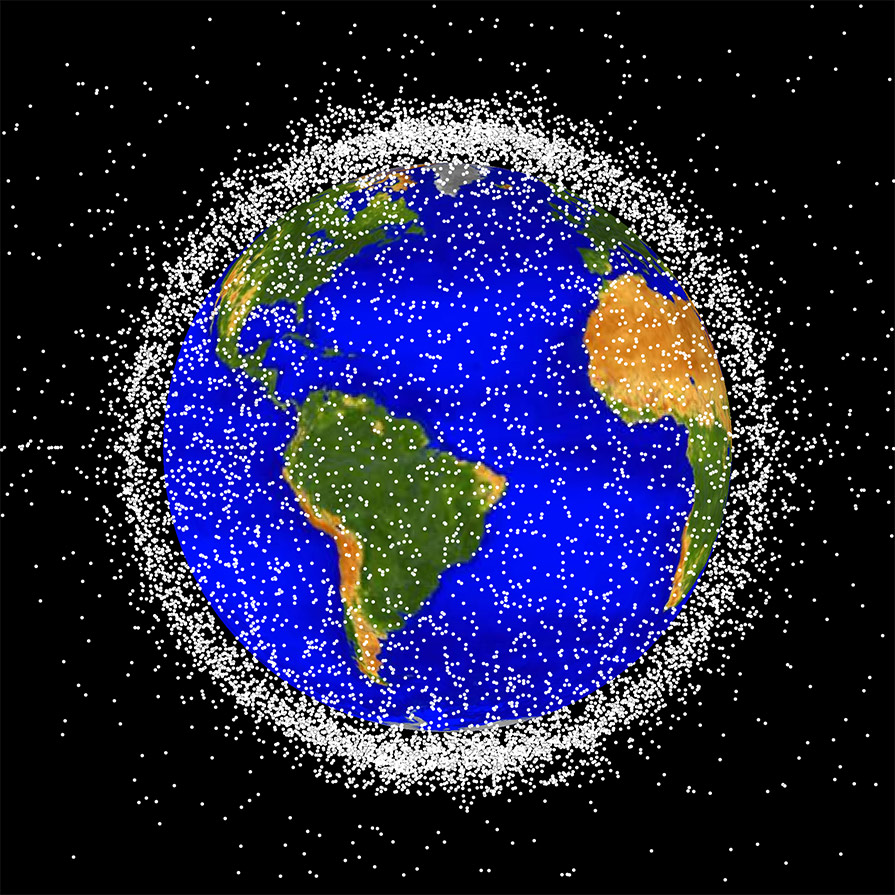On October 16th 2020, about 1.000 kilometers (621 Miles) above Earth, two derelict space craft almost collided. One a soviet era navigation satellite launched in 1989, the other a Chinese rocket booster launched in 2009 passed within 12 meters of each other. A collision would have created a large cloud of debris which would pose an imminent threat to other spacecraft and potentially cause a chain reaction, the Kessler Syndrome. [1]
The Nasa Astronomer Donald J. Kessler proposed in 1978, that colliding space debris could lead to a chain reaction effectively putting an end to all space activities and the use of satellites impossible for centuries. He predicted that with the increasing number of objects that are launched into low Earth Orbit the density would lead to inevitable collisions that could cause a cascading effect. [2] As the number of artificial satellites in Earth orbit increases, the probability of a collision between them also increases. Satellite collisions would produce orbiting fragments, each of which would further increase the probability of collisions, leading resulting in a belt of debris around Earth.[3] As of 2020, more than 23,000 fragments of orbital debris larger than 10 cm are known to exist. The estimated population of particles between 1 and 10 cm in diameter is approximately 500,000, the number of pieces larger than 1 mm exceeds 100 million. While many of these fragments are very small indeed [4], they however travel at speeds up to 10 km/s (22,000 mph). A 1 centimeter paint fleck is capable of inflicting the same damage as a 250 kilogramm (550 pound) object traveling at 97 km/h (60 mph) on earth, a 10 centimeter projectile would be comparable to 7 kilograms (14 pound) of TNT. [5]
Space 2.0
The 21st century has brought a dynamic development to the space industry. The few national space agencies such as American NASA, European ESA, Japanese JAXA, and Chinese CNSA were joined by private entrepreneurs like SpaceX, Blue Origin, and Virgin Galactic. The participation of the private sector in the space industry has skyrocketed in the last years, especially in the United States. The US based SpaceX is currently the only entity that provides reusable rockets that are capable of vertical launch and landing. [6] The company is also responsible for Starlink, a satellite based low latency broadband internet system. Since November 2020 860, and by the end of June 2021, more than 1,660 Starlink satellites are orbiting Earth, with plans to launch a total of 11,927 by 2027. [7] While SpaceX’s Starlink is progressing at a rapid pace, it is not the only satellite network being planned. There are at least a few initiatives with similar goals to construct internet and communication infrastructure in Earth’s orbit. [8]
Outlook
According to Kesslers model, even if the “current” population of spacecraft would remain constant, random collisions and accidents would increase the number of fragments at a faster rate than they can naturally be removed from space. If, however the number of spacecrafts grow, the rate of collisions also increases which will increase the number of fragments significantly. [9] If Kesslers predictions in the shape of the Kessler Syndrome would come to pass, our entire satellite-based information technology, GPS, Galileo, Television, as well as scientific and military endeavours would be under threat. [10]
There are some measures being taken to oppose the looming threat of uncontrolled space debris. Large orbital debris (> 10 cm) is being tracked by the U.S. Space Surveillance Network, while objects as small as 3 mm can be detected by ground-based radars. [11] The UN has defined a set of guidelines titled: “Mitigation actions against space debris proliferation”[12], while national Space Agency’s such as NASA have policies to minimize the creation of new orbital debris. Many private firms voluntarily adhere to measures designed to limit the growth of orbital debris as well. [13] However, with the current development being driven by profit and unlimited by means of international regulations, the threat of the Kessler Syndrome is growing with each new launch into space. [14]
PS: Check out this YouTube short-film about the Kessler Syndrome that features Donald Kessler himself.
References:
Bernat, P. (2020): ORBITAL SATELLITE CONSTELLATIONS AND THE GROWING THREAT OF KESSLER SYNDROME IN THE LOWER EARTH ORBIT. In: Safety Engineering of Anthropogenic Objects Volume 4/2020, Military University of Aviation.
Crane, Lea (2020): Two old spacecraft just avoided catastrophically colliding in orbit. In: New Scientist. https://www.newscientist.com/article/2257525-two-old-spacecraft-just-avoided-catastrophically-colliding-in-orbit/ (25.09.2021)
Kessler, D., J., and Burton, G. (1978): Collision Frequency of Artificial Satellites: The Creation of a Debris Belt. In: Journal of Geophysical Research, Vol. 83, No. 46, p. 2637-2646.
Kessler, D., J. (2000): Critical Density of Spacecraft in Low Earth Orbit: Using Fragmentation Data to Evaluate the Stability of the Orbital Debris Environment. Lockheed Martin Space Operations Company
Kessler Syndrome | Space Junk (2012): https://www.youtube.com/watch?v=xgGm5odlIh4&t=156s (25.09.2021).
NASA (2016): Micrometeoroids and Orbital Debris (MMOD). https://www.nasa.gov/centers/wstf/site_tour/remote_hypervelocity_test_laboratory/micrometeoroid_and_orbital_debris.html (26.09.2021)
NASA (2020): Astronomical Research & Exploration Service, Frequently Asked Questions. https://orbitaldebris.jsc.nasa.gov/faq/# (25.09.2021)
Ratner, Paul (2018): How the Kessler Syndrome can end all space exploration and destroy modern life. In: Big Think.
https://bigthink.com/surprising-science/how-the-kessler-syndrome-can-end-all-space-exploration-and-destroy-modern-life/ (25.09.2021)
Wikipedia (2021): Starlink. https://en.wikipedia.org/wiki/Starlink
[1] (Crane (2020)
[2] (Ratner 2018)
[3] (Kessler and Burton 1978, p. 2637)
[4] (NASA 2020)
[5] (NASA 2016)
[6] (Bernat 2020, p.1-2)
[7] (Wikipedia 2021)
[8] (Bernat 2020, p. 11)
[9] (Kessler 2000, p. 45)
[10] (Ratner 2018)
[11] (NASA 2020)
[12] (Bernat 2020, p. 8)
[13] (NASA 2020)
[14] (Bernat 2020, p.12)

